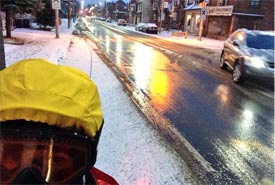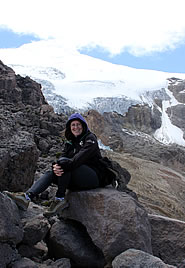How to bike in the winter: The gear you need to do it while staying warm and dry.

Twitter user @jsquaredink's first winter commuting by bike (Photo courtesy @jsquaredink)
I am a big proponent of the idea that for most of the year, you don’t need special clothing to ride a bike. You the need the bike, a lock, a light, a helmet depending on your preference and the laws where you are, and then you can ride to your heart’s content! But when it gets colder, a few extras help to keep me warmer than I would be with the clothes and gear I already had in my closet. I wear my regular winter coat (a “puffy” coat) and that seems to do the trick for my core, but the areas I worry about the most are my extremities — head, hands and feet.

Kyla rode to a date in mid-December when it was a little below freezing (Photo by Kyla Winchester/NCC staff)
Head
I wear a toque under my regular helmet for most of the winter, but this morning I dug out my balaclava for today’s extra-chilly ride. It helped keep my ears warm, and was an extra layer around my neck where the wind can sneak in. The other cycling item I wear in the winter is a neck warmer. I have found regular scarves to be bulky, and they shift when I turn my head to shoulder-check, so for me a neck warmer is the way to go.
Some folks recommend other gear — ski goggles, ski/snowboard helmets, helmet cover — but go with your own preference. Try cycling on a relatively warm day for your local winter conditions with whatever you think will work, then get extra layers as needed.
Hands
Winter cycling gloves are one of the only "special" items I really think you need to ride in the winter. Regular gloves and even mittens aren’t warm enough for riding, and they are also often too slippery to grip brakes levers in the cold. As well, as a road bike rider, I appreciate split “lobster” claw gloves that allow me to keep two fingers on the handlebars and two fingers on the brakes, but that are a little warmer than regular gloves with all fingers separate.
This morning I used my regular winter gloves with thick gloves underneath and it seemed to do the trick, though it was little tight. However, when it comes to keep hands warm, a lot of people swear by pogies — basically they are covers for your handlebars, that allow you to hold the handlebar, reach the brakes and still shelter your hands from the cold. I haven’t found a road bike pair I like, but mountain bike-style handlebars can be well protected.
Feet
My toes do get a little chilly during winter riding. Because I ride so much, I bought boots that I could wear for riding, and deliberately bought them a little big so I could layer socks underneath. Before Christmas, my toes were chilly, but this morning I did nothing different and had no problems! I can only assume everything else was warm enough that extra heat to send to my feet, which I have to say I am quite happy about.
In essence, my advice regarding keeping feet warm is to layer. However, if you would like to go an extra step, they do make covers for shoes that you could wear over your boots in the winter (with the bonus of keeping rain out of your shoes during the warmer weather).
Bonus! Legs and lights
I wear dresses to work, and continue to do so in the winter. However, a dress and tights are not the warmest clothing combination, so another acquiescence I made to winter gear was to buy winter cycling leggings. They have ankle zips, a high waist and are fuzzy inside for extra cosiness. I wear them over my tights and take them off when I get to work, and they have lasted me many years of winter riding, far offsetting the cost.
You could also buy wind/waterproof pants and wear them over your regular pants to keep the wind out when it gets below freezing.
To be safe, I recommend an extra front light and an extra rear light in the winter. It definitely helps your visibility to have two lights, but it’s also a good precaution to take so you don’t get stuck riding home with a light with a dead battery. If one dies, you have a backup and can re-charge/change the batteries on the other when you get home. And if it’s a rear light, it can easily lose power while you’re riding and you won’t notice until you get home. A backup can save you from a collision or even from getting a ticket.
Everyone!
Have I convinced you to ride in the winter yet? Here is my last push: just like in the summer, cycling in the winter is cheaper than the alternatives. It’s healthier, reducing your risk of many lifestyles ailments, and takes less time than commuting and then going to the gym. It wakes you up and puts you in a post-exercise good mood when you get to work. And the bonus: in light snow, cars may be slower and even get stuck in the traffic that miraculously appears in bad weather. However, cyclists can still move when cars are stuck behind the car in front of them (though I try not to look like I’m gloating when I coasting past them, as I’m sure they don’t gloat when they see me riding in when it’s 11 degrees below).
If you have any winter riding suggestions, or if you try riding and run into some challenges, I’d love to hear them. Happy winter riding!


